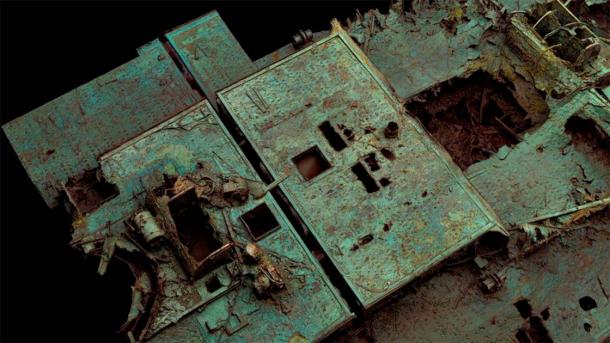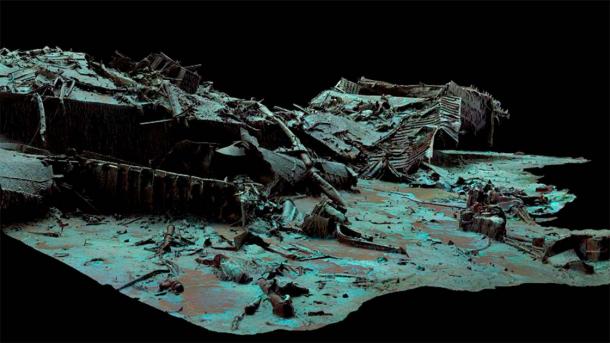See The Titanic as Never Seen Before in ‘Largest Underwater Scanning Project in History’
History’s most famous shipwreck of the iconic liner, the R.M.S. Titanic, which caused the death of 1,500 people when it sank in 1912, has now been the subject of the largest underwater scanning project in history. Utilizing state-of-the-art deep-sea mapping technology, researchers have successfully created the first complete digital scan of the Titanic. This ‘Digital Twin’ offers a remarkable 3D visualization of the entire vessel as if the surrounding water had miraculously vanished.
Parks Stephenson, a respected Titanic analyst, emphasized the significance of this monumental breakthrough. "There are still fundamental questions about the ship that remain unanswered," he stated, emphasizing the importance of pursuing evidence-based research rather than relying on speculation. The digital model of the Titanic represents a major step forward in unraveling the mysteries surrounding the ship's fate, according to a BBC report.
Stephenson, an expert who has been studying the Titanic for 20 years, hailed the project as a “gamechanger” which has managed to unearth “details never seen before…. We’ve got actual data that engineers can take to examine the true mechanics behind the breakup and the sinking and thereby get even closer to the true story of the Titanic disaster,” he added.
- Researcher Shows Northern Lights May Have Led to Titanic Sinking
- Bringing Centuries of Bad Luck: 10 Unlucky Artifacts and Cursed Archaeological Sites
An Audacious Use of Technological Scanning
While numerous exploration missions have been conducted since the discovery of the wreckage in 1985, previous attempts to capture the full essence of the Titanic were hindered by its colossal size and the murky depths in which it resides. As a result, only fragmented glimpses of the decaying vessel were available off the coast of Newfoundland, where it was found.
This new scan has allowed an unparalleled comprehensive view of the Titanic in its entirety. Divided into two sections—bow and stern—with a distance of approximately 800 meters (2,600 feet) separating them, the wreckage lies within a sprawling debris field. The researchers used two submersibles, named Romeo and Juliet, to map “every millimeter” of the wreckage, reports The New York Times.
- The Antikythera Shipwreck – The Titanic of the Ancient World
- The Trials and Tribulations of BM 22542 (1889,0731)

700,000 images have produced a scan of ‘every millimeter’ of the wreck. (Atlantic Productions/Magellan)
The scanning project, which took place during the summer of 2022, was a collaborative effort between Magellan Ltd, a prominent deep-sea mapping company, and Atlantic Productions, renowned for their captivating documentaries. This ambitious endeavor involved deploying specialized submersibles, remotely operated by a skilled team aboard a dedicated vessel, which meticulously surveyed every inch of the wreck.
Over 700,000 meticulously captured images from various angles provided the necessary data to construct an accurate and intricate 3D model, along with the generation of 16 terabytes (TB) of data, reports CNN. This is “approximately ten times larger than any underwater 3D model that’s ever been attempted before,” Magellan CEO Richard Parkinson said.

A top view image, showing a large whole where the grand staircase once stood. (Atlantic Productions/Magellan)
Overcoming Challenges and Obstacles: A Deep Dive
“This was a challenging mission. In the middle of the Atlantic we had to fight the elements, bad weather and technical challenges to carry out this unprecedented mapping and digitalization operation of the Titanic,” added Parkinson.
It was not without its challenges and obstacles – a formidable depth of nearly 4,000 meters (12,500 feet), compounded by persistent underwater currents. Utmost care had to be taken not to disturb any elements of the wreck to avoid causing damage. Mapping every minute detail, including seemingly unremarkable portions such as the debris field and mud, proved to be an additional challenge. The low light through it all was a major obstacle to bypass as well.

The stern of the Titanic twisted and separated from the bow on its journey to the seabed. (Atlantic Productions/Magellan)
The Titanic: Then and Now
The discovery of the Titanic at the bottom of the Atlantic Ocean was a momentous event that occurred on September 1, 1985, during an expedition led by Jean-Louis Michel and Robert Ballard. Prior to this expedition, the exact location of the wreck had remained a mystery for over seven decades.
Upon reaching the wreck site, it became evident that the Titanic had split into two main sections—the bow and the stern. These sections lay approximately one-third of a mile apart from each other. Surprisingly, the bow was found to be relatively well-preserved, considering its descent to the ocean floor. However, the stern exhibited severe structural damage, likely a result of the impact it endured during its plunge, reports Ars Technica.
The Titanic met its unfortunate fate four days into the Atlantic crossing, 600 kilometers south of Newfoundland on the 14th of April, 1912. The infamous iceberg was hit at around 11:40 p.m., flooding five of its 16 watertight compartments, thereby sealing its fate. More than 1,500 passengers and crew perished; only around 710 of those on board survived.
New, Unprecedented Details of Titanic Wreck
The new scan provided previously unexplored intricacies - notably, the serial number on one of the propellers is now clearly visible. The once-iconic bow is now adorned with rust stalactites. Resting atop the bow is the boat deck, featuring a conspicuous aperture into the void where the grand staircase once stood.
In stark contrast, the stern of the ship presents a chaotic mess of twisted metal. This part of the vessel collapsed as it spiraled toward the seabed. Scattered throughout the surrounding debris field are remnants of the ship, including ornate metalwork, statues, and unopened champagne bottles. Additionally, personal belongings, such as dozens of shoes resting on the sediment are haunting reminders of this past.
"This model is the first one based on a pure data cloud, that stitches all that imagery together with data points created by a digital scan, and with the help from a little artificial intelligence, we are seeing the first unbiased view of the wreck. I believe this is a new phase for underwater forensic investigation and examination,” concluded Stephenson.
Top image: Still of the 3D Imagery film of the Titanic wreck on the seabed. Source: Atlantic Productions/Magellan
By Sahir Pandey
References
Kennedy, M. 2023. ‘Largest underwater scanning project in history’ gives never-before-seen view of Titanic. Available at: https://edition.cnn.com/travel/article/titanic-digital-twin-underwater-scanning-intl-scli-scn/index.html.
Morelle, R., Francis, A. 2023. Titanic: First ever full-sized scans reveal wreck as never seen before. Available at: https://www.bbc.com/news/science-environment-65602182.
Rubin, A. 2023. ‘Digital Twin’ of the Titanic Shows the Shipwreck in Stunning Detail. Available at: https://www.nytimes.com/2023/05/17/science/titanic-shipwreck-3d-images.html.



















